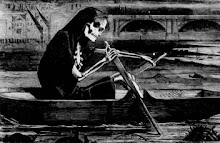Given that I've been posting shots from the Mk IV for a while now, I thought I'd therefore take a break here and provide an update on impressions so far.
Just to be clear at the outset, this is not a technical review; frankly, it's nothing other than a set of subjective notes based upon my own personal experiences with the camera, set against the sorts of things I like to shoot and how I like to shoot them. So there. And now, on with the show.
Handling: compared to the 20D it is of course heavier but actually not that much, and really once you stick a decent sized bit of glass on the front then the difference is much smaller than you first think. Compared to the Mk III the physical feel is all but identical, though that's not all to the good as will be covered later.
Reliability: no issues so far in that department. I've run a couple of thousand shots through it so far without suffering any physical hiccups. Along similar lines, one of my reasons for going to a 1 series body was to get away from the curse of dust always collecting on the sensor, and so far that goal, too, has largely been satisfied. I did get a few specs show up while in Death Valley but having cleaned those off then things seem to have stayed spot-free since.
Image Quality: With the caveat that I've done very little at ISOs higher than 800 then I've been very happy indeed with with results. Firstly, straight out of the camera images have better colour, clarity and presence, and hence require less processing in order to get close to what you want the final result to be. Secondly, the extra pixels mean that you have more leeway when cropping before image quality degrades. Thirdly, files take sharpening very well - at least for screen viewing - but I've yet to print many Mk IV shots so I'll reserve judgement a little on what works vs. what doesn't in that area until I have some more experience. Lastly, image noise is very well controlled. At the per-pixel level, it's comparable or better than a Mk 3 and up to a stop better than a 20D, but the extra pixels add about another half stop to the first comparison point and a full stop to the second. In short, forget about it. Noise isn't an issue: this sensor is better than film and perfectly usable up to 1600 without you having to give it much of a thought.
Features: There are a slew of new capabilities added to the Mk IV but here I'll concentrate on the things I've found useful. Starting at the top, I am now a devoted fan of live view. Before trying it then I was sceptical to say the least that it was worth all the attention it has drawn. I have other cameras that are mirror-less that of course use the same basic approach and frankly always missed the viewfinder option. However, when doing landscape shots or for night shooting then I now default to live view and rely almost solely on the screen on the back of the camera. For landscape work you can place the camera in hard-to-get-at locations, very close to the ground for example, and yet are still able to compose, meter, focus and shoot without having to contort yourself to find a place where you can look through the viewfinder. For night shooting you can use the 10x magnification capability on live view in order to focus, a revelation to me and something that on its own makes this technology all worthwhile. Bliss. Live view is now a regular part of my shooting and I'd very much miss it if I had to give it back. And along with live view we of course also get HD movie recoding. I will get round to testing this at some point, I promise, but not yet. Try me again after ALMS at Laguna later in May! Other stuff? Auto bracketing can now be set for up to 7 shots and exposure compensation is available for +/- 3 stops, both of which are worthwhile improvements. And yes, auto focus is much better than on the 20D and, subectively at least, feels better than on the Mark 3.
Features Missing: For a start, most of the electronic toys first seen on the 7D, such as an electronic level, for example; dedicated movie switch (going between live for for stills and movie mode requires going back into the depths of the menu tree and you are best served using the FEL button - itself too tiny - for movie recording); still no way of using what the camera knows about itself to calculate DOF and display the result; no way to set narrow focus with the centre point unless you have a lens with available "stop" button; no built-in auto-shot timing al la the TC803 remote; no built-in WiFi or GPS. Seriously, $5k and now with a body and features that are largely 5 years old? Come on Canon, this is not good enough. The simplest of these - leaving off adding a dedicated switch between movies and stills - just feels like Canon was too cheap to change the body of the Mark III in any way at all.
Summary: All-in-all, I'm very satisfied with the main items, image quality and robustness, and am enjoying using it. Sure, there are niggles and things that I think Canon have fallen short on, especially on the level of features appropriate for a camera launched in 2010, but there you have it. If what you shoot matches the well-covered strengths of this camera, and you have the necessary wedge to spend, then go for it. I did, and have no regrets.


1 comment:
Post a Comment